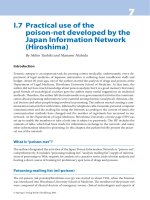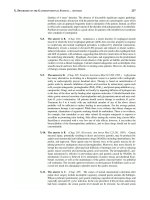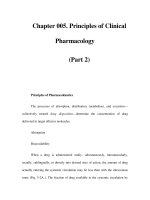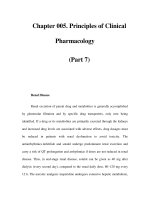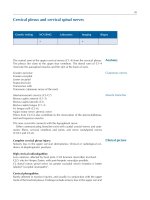Atlas of Clinical Hematology - part 7 ppt
Bạn đang xem bản rút gọn của tài liệu. Xem và tải ngay bản đầy đủ của tài liệu tại đây (3.57 MB, 44 trang )
IV
Fig. 110 e – f
e Higher-power view of d
f ANAE reaction in the same smear
256 Chapter IV · Blood and Bone Marrow
IV
Fig. 111 a – e. Recurrence of AML with
deficient granulocyte maturation
a Bone marrow at onset of the
recurrence shows increased blasts
b Mature granulocytes are still relatively
abundant but are accompanied by
markedly dysplastic, polypoid forms
c, d Peroxidase reaction differentiates
granulocytes that are still normal from
the predominantly dysplastic granulo-
cytes, which are peroxidase-negative
257
5 · Bone Marrow
IV
Fig. 111 e CE reaction shows the same
pattern as peroxidase
258 Chapter IV · Blood and Bone Marrow
IV
Rare Acute Myeloid Leukemias
(Figs. 112 – 114)
Fig. 112 a – h. Acute eosinophilic
leukemia
a Blasts with reddish to purple granules
and some large vacuoles that contain
coarse inclusions
b Some of the granules are dark purple
and highly variable in appearance
c Large vacuoles containing orange-
colored granules
d, e Peroxidase reaction. Two neutro-
philic precursors are seen at top and
center. All other cells contain variable
granules, some quite large an d some
with central pallor. These granules cor-
respond to eosinophilic granules in pre-
cursors
259
5 · Bone Marrow
IV
Fig. 112 e – h
f, g CE reaction. The granules ( red) are
CE-positive and correspond in size and
shape to those with peroxidase activity
g
h The cells were identified as immature
eosinophils by the positive Adam reac-
tion of the granules (here grayish-blue)
and by staining with luxol fast blue and
the peroxidase modification for eosino-
phils. A specific chromosome aberration
could not be identified in this patient,
and molecular genetic analysis did not
detect inversion 16 (CBFb/MYH11)
260 Chapter IV · Blood and Bone Marrow
IV
Fig. 112 i, j Two additional cases of
eosinophilic leukemia with a higher
degree of maturation but also with
atypical eosinophilic granulocytes
containing very fine granules. Both
patients were men, 20 and 63 years of
age
i
Clumped purple granules and pleo-
morphic nuclei in the cells of the 20-year-
old man. As in the case above, the
granules gave a positive Adam reaction.
Cytogenetic analysis identified a
t(10;11)(q11;p13 – 14) translocation. The
Wilms tumor gene (wt1) was expressed, in
contrast to hypereosinophilic syndrome
j The 63-year-old man had immature
cells, also with Adam-positive granules.
Some of the granules were CE- and
peroxidase-positive. No chromosome
abnormalities were found. The greater
than 30 % proportion of blasts clearly
identifies the disease as an acute leuke-
mia
261
5 · Bone Marrow
IV
Acute basophilic leukemia
(Fig. 113 a – e)
These cases require differentiation from
a basophilic phase of CML and from
tissue mast cells leukemia
Fig. 113 a – d.
a, b Acute basophilic leukemia with a
large proportion of blasts. Some cells
contain abundant basophilic granules,
and scattered inclusions like Auer rods
are seen. Pappenheim stain (a), toluidine
blue stain (b)
c Higher degree of maturation in a
different patient
d Toluidine blue stain
262 Chapter IV · Blood and Bone Marrow
IV
Fig. 113 e
e Distinct, in part large granules in a
different patient
263
5 · Bone Marrow
IV
Hypoplastic AML (Fig. 114 a –d)
Sample evaluation is feasible in these
cases only if sufficient bone marrow
fragments can be aspirated and
mounted as smears. Otherwise the case
should be evaluated by core biopsy and
histologic examination. It can be very
difficult to distinguish this variant of
AML from aplastic anemias. Even his-
tologic examination of the bone mar-
row can be misleading unless blasts are
positively identified. The diagnosis re-
lies on demonstrating a frequently cir-
cumscribed collection of blasts. Spora-
dic cases of acute lymphocytic leukemia
may also start with an aplastic preli-
minary stage, and frequent follow-ups
are necessary to establish a clear di-
agnosis
Fig. 114 a – d.
a Hypocellular bone marrow with
increased fat cells
b Higher-power view of a more cellular
site shows myeloblasts and erythroblasts
(left and bottom)
c Hypocellular bone marrow in a
different patient
d Myeloblasts and isolated lymphocytes
in an isolated hypercellular area of the
same sample
264 Chapter IV · Blood and Bone Marrow
IV
5.10.2 Acute Lymphoblastic
Leukemia (ALL) (Fig. 115 a – d)
Fig. 115 a – d.
a Small blasts. These may closely
resemble lymphocytes but are distin-
guished by their finer chrom atin struc-
ture and the occasional presence of nu-
cleoli
b Different case showing blasts of
varying sizes, some with pleomorphic
nuclei. Panels a and b illustrate B-lineage
ALL
c Peroxidase reaction. All lymphoblasts
are negative and are interspersed with
residual cells of granulocytopoiesis,
whose proportion is more clearly
demonstrated by the peroxidase reaction
d Terminal deoxynucleotidyl transferase
(TDT), detected by the immun operoxi-
dase reaction in the nuclei. TDT is not
specific for lymphoblasts but is useful for
differentiating forms of ALL from mature-
cell lymphatic neoplasias and large-cell
lymphomas. Today this reaction is usually
performed in a fluorescence-activated
cell sorter
265
5 · Bone Marrow
IV
B-lineage ALL (Fig. 116 a –g)
Fig. 116 a – d.
a The pan-B marker CD19 is very useful
for the immunocytochemical detection
of B-cell lineage. 100 % of the blasts in
this sample are positive (red)
b Contrast with the T-lineage marker
CD3: the blasts are negative, and
interspersed mature T lymphocytes are
positive (same case as a)
c Different case with lymphoblasts of
varying size
d Same case as c, demonstration of
CD 19
266 Chapter IV · Blood and Bone Marrow
IV
Fig. 116 e – g
e Same case as c and d, demonstration of
CD10. The detection of CD19 and CD10
correspond to c-ALL (BII)
f PAS stain yields a granular reaction in a
variable percentage of lymphoblasts,
which show a coarse granular or floccu-
lent reaction pattern
g Coarse granular and globular PAS re-
action in a different case. The reaction
pattern seen in f and g, when combined
with a pale cytoplasmic background and
negative peroxidase and ANAE, provides
morphologic and cytochemical evidence
of ALL
267
5 · Bone Marrow
IV
Fig. 117 a – g B-lineage ALL
a A range of morphologic features may
be found in B-lineage ALL. This sample
shows relatively large blasts with an
intensely basophilic cytoplasm
b Large blasts with marked cytoplasmic
budding, at first suggesting megakaryo-
blastic leukemia. Both a and b represent
B-lineage ALL
c Vacuolation is not uncommon in ALL.
Relatively large vacuoles are seen in this
case
d Vacuoles in a different case. The coarse
granular PAS reaction in the cytoplasm is
not associated with the vacuoles
268 Chapter IV · Blood and Bone Marrow
IV
Fig. 117 e – g
e Large, partially confluent vacuoles in a
different patient
f PAS reaction in the same case (e) shows
that the vacuoles are filled with glycogen
g Peroxidase reaction in the same case
clearly demonstrates the vacuoles in the
peroxidase-negative blasts
269
5 · Bone Marrow
IV
Fig. 118 a – d. Mature B-ALL (B IV) cor-
responding to the FAB subtype L3. This
subtype of ALL is rare, but its recogni-
tion is important because the prognosis
can significantly improve with specific
therapy. Morphologic examination
shows round, relatively uniform blasts
of moderate size with intensely baso-
philic cytoplasm and sharply defined
(fat-containing) vacuoles
a–c Various examples of this subtype of
ALL
b
c
d Bone marrow smear in which
infiltration is confined to the upper part
of the field
270 Chapter IV · Blood and Bone Marrow
IV
Fig. 119 a – h. ALL with cytoplasmic
granules. One morphologic subtype of
ALL violates the dogma that cytoplas-
mic granules are suggestive of AML.
This case is a B-lineage type of ALL with
cytoplasmic granules that are peroxi-
dase-negative and behave as lyso-
somes
a Blasts above the center of the field
contain coarse purple granules. Several
finer granules are visible below
b PAS reaction. The abnormal granules
stain pink, contrasting with the burgun-
dy-red staining of the other glycogen
granules
c ANAE reaction. The distinct, intensely
reacting granules in the cytoplasm
correspond to those seen in a and b
d Another case with very prominent
dark-purple granules. They might be
mistaken for basophilic granules but are
distinguished by an absence of
metachromasia
271
5 · Bone Marrow
IV
Fig. 119 e – h
e Relatively large, intensely staining
granules in a different case
f Acid phosphatase reaction. Some of
the granules are markedly positive
g, h Electron micrographs reveal large,
membrane-bound inclusions in the
cytoplasm with finely granular contents
corresponding to the granules described
above. (Courtesy of Prof. Dr. Mu¨ ller-Her-
melink, Wu¨rzburg)
h
272 Chapter IV · Blood and Bone Marrow
IV
Fig. 120 a, b. Chromosome abnormal-
ities in ALL. The (9;22) translocation in
ALL indicates a particularly unfavorable
prognosis. This finding corresponds
cytogenetically to that described in
CML. In terms of molecular genetics, the
minor breakpoint cluster region (m-bcr)
is predominantly affected in ALL. a The
(4;11) translocation, which also imp lies
a poor prognosis. b The translocation
t(8;14) (q24;q32), connected to Burkitt
lymphoma and mature B-ALL (B IV)
a
b
273
5 · Bone Marrow
IV
T-lineage ALL (Fig. 121 a –e)
Usually the B-cell and T-cell forms of ALL
are morphologically indistinguishable.
The pronounced irregularity of the nu-
clear contour (“convoluted nucleus”) and
high rate of mitoses are more consistent
with T-ALL
Fig. 121 a – c.
a Pappenheim stain in T-ALL
b The focal or paranuclear acid phos-
phatase reaction pattern shown here is
typical of T-lineage ALL
c Acid phosphatase reaction using a
different technique (Sigma)
274 Chapter IV · Blood and Bone Marrow
IV
Fig. 121 d, e
d A case of T-ALL with consistently
round nuclei
e Another case with some irregular
nuclear contours
275
5 · Bone Marrow
IV
Fig. 122 a – d. T-lineage ALL
a Vacuolation of the cytoplasm may also
be observed in T-ALL
b Acid phosphatase reaction at a typical
location in the same case
c Detection of CD3 in the same case
d Basophilic cytoplasm and vacuoles in a
different case
276 Chapter IV · Blood and Bone Marrow
IV
Other Morphologic Variants of ALL
(Fig. 123 a–h)
Fig. 123 a – d.
a “Hand-mirror” form with a handle-like
extension of the cytoplasm. T his
morphologic subtype of ALL has no
special significance but is shown to avoid
confusion with monoblasts
b Different case with fine granules and a
hand-mirror configuration of the
cytoplasm
c Detection of CD19 in smears from the
same patient
d Detection of CD10 in a smear from the
same patient. Findings are consistent
with c-ALL
277
5 · Bone Marrow
IV
Fig. 123 e – g
e Very rarely, pseudo-Gaucher cells are
also found in ALL. This case involves a
T-ALL
f Acid phosphatase reaction in the same
case shows strong activity in the cyto-
plasm of a pseudo-Gaucher cell and a
focal reaction in lymphoblasts
g Bone marrow smear of a patient with
c-ALL and eosinophilia and the rare
translocation t(5;14). In the center, one
blast and the nucleus of a blast, above
and below one eosinophil each
278 Chapter IV · Blood and Bone Marrow
IV
Acute Leukemias with Mixed
Phenotypes
Fig. 124 a – g. Acute leukemias invol-
ving the lymphatic and granulocytic
cell lines (hybrid, biphenotypic, bi-
linear, mixed lineage). The European
Group for the Immunological Charac-
terization of Leukemias has proposed a
point system to assist in classification
which has been taken over by WHO [see
Bene, MC et al (1995) Proposals for the
immunological classification of acute
leukemias. European Group for the
Immunological Characterization of
Leukemias (EGIL). Leukemia. 9: 1783–
1786]. These types of leukemia most
commonly occur in early T-ALL with
myeloid markers. They also occur in
true bilinear forms and occasionally in
Philadelphia-positive forms of ALL,
which also have a myeloid component
a Lymphatic blasts are interspersed with
scattered mature lymphatic cells and
large blasts with somewhat pleomorphic
nuclei and lighter cytoplasm
b Higher-power view shows reddish
granules in the cytoplasm of the larger
blasts (lower right of center)
c A number of the large blasts are po-
sitive for peroxidase stain, confirming
their granulocytic lineage
d The peripheral blood contains very
small numbers of mature granulocytes
with Auer rods
279
5 · Bone Marrow
IV
Fig. 124 e – g
e Almost all the blasts express CD13 on
immunocytochemical analysis
f More than 60 % of the small blasts are
CD3 – positive. Panels a through f illus-
trate the coexistence of T-ALL and AML
g In another case previously classified as
T-ALL, we found myeloid precursors with
atypias (center right, upper left), again
demonstrating the involvement of
granulocytopoiesis
280 Chapter IV · Blood and Bone Marrow
